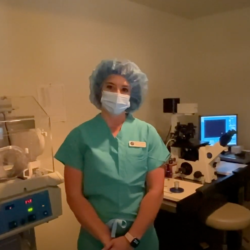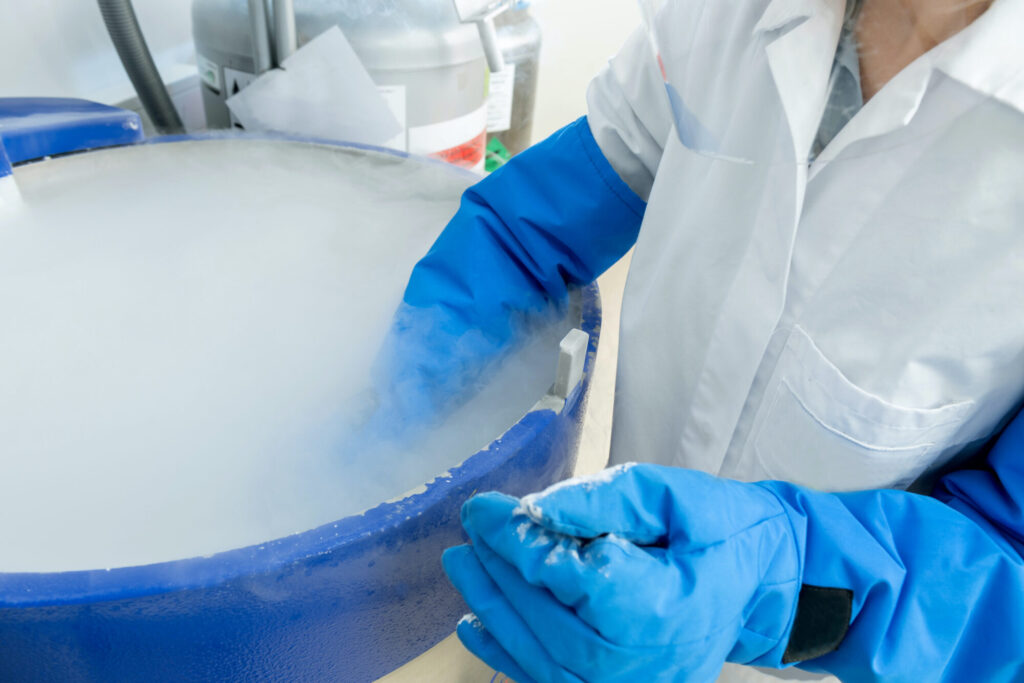
Egg freezing for social reasons is becoming more popular, but determining whether that or embryo freezing is the best option to extend fertility may require a crystal ball.
Reasons to extend fertility through social egg freezing or embryo freezing
Sometimes a medical condition like facing fertility-damaging chemotherapy for cancer is the reason a woman chooses to preserve her fertility through oocyte freezing, or egg freezing. But “social egg freezing” is a more common way to extend fertility.
This is when a woman decides to preserve her fertility for nonmedical reasons. A woman may not be ready to begin a family, either because of financial needs, professional needs or she hasn’t found a life partner with whom to build a family. Fertility preservation offers the possibility of prolonging her childbearing ability through egg or embryo banking that essentially extends fertility.
The biological clock ticks away chances of conception
The ability to conceive drops as women age, particularly as they move through their 3rd and into their 4th decade. This is directly related to the natural loss of gametes (reproductive cells) as women get older, sometimes called “gamete exhaustion.”
Fertility preservation consultation: What does your future look like?
The initial consultation before egg or embryo freezing for social reasons usually involves an informational consultation with the provider, in which fertility preservation options are discussed. Then we give the patient details of the processes and costs involved. If an anti-Müllerian hormone (AMH) level hasn’t been assessed, that should be completed and discussed during the conversation.
More important, however, is the patient’s assessment of why she is seeking fertility preservation and why now. In helping the patient to come to the correct decision (to do or not to do? oocyte or embryo banking?), it is important to understand her own personal narrative. How is it that she is here now? And what does the future look like?
Deciding on freezing embryos vs. freezing eggs – without a crystal ball
FINO works with patients to determine the best course of treatment together, making a whole-body decision based on finances, emotion, biology and even spirituality.
The most widely practiced fertility preservation options in post pubertal females include egg freezing and embryo freezing. The decision on whether to freeze eggs or embryos can be a difficult one.
Seeking fertility preservation implies that the individual is either not interested in parenting at the present time (either for social and/or financial reasons) and/or is strongly averse to single parenting and is waiting to meet a life partner with whom to share family building.
Knowing whether to freeze eggs or embryos requires, in part, a read into the future and future relationships, which is nearly impossible. To deal with this difficult quandary, some patients opt to freeze both oocytes and embryos. This will give them more future options, but it usually requires more than one stimulation and retrieval to capture enough oocytes to bring this about.
Pros & cons of embryo freezing to extend fertility
More important than the crystal ball are the questions of how strong is my desire to parent? And what steps am I willing to take to ensure that desire?
The advantage to using embryos (fertilized eggs) for fertility preservation are several. Embryo freezing is an established procedure with which all in vitro fertilization (IVF) programs have proficiency, and success rates are well established. The first embryo freezing that resulted in a live birth was successfully performed in 1984 and was performed for eggs in 1999. Additionally, if the egg is fertilized prior to freezing, there is one less manipulation that it must undergo prior to making its way to possible transfer and implantation.
The disadvantage of embryo freezing instead of egg freezing is that a sperm source is needed and therefore will mean the use of donor sperm if the woman is not using a current partner’s sperm. And, ultimately, the use of these embryos may be resisted by a future partner.
Egg freezing pros & cons
The advantages to freezing eggs is that sperm are not needed. This results in more reproductive autonomy for the women who don’t have a partner at the time of egg retrieval. The number of eggs that can be retrieved is first and foremost dictated by the patient’s ovarian reserve (determined by genetics and age). AMH is a serum marker used to indicate how many eggs remain in the ovaries and can be helpful in guiding each patient to a decision. Generally, patients with higher AMH levels can expect to have more eggs retrieved after stimulation.
Can You Get Pregnant With Low Hormone Levels?
Egg or embryo freezing FAQ
Probably the most frequent question asked is, How many eggs do I need to plan on freezing? followed by, What is the likelihood that a baby will result from my efforts? There is little conclusive information on those questions.
Researcher Ana Cobo and colleagues have suggested that one needs 10-15 oocytes to have an 85% chance of live birth. Of course, age at the time of the retrieval is the most important predictor of the ultimate success rate once the eggs are thawed. For women undergoing thawing of an embryo that was created from a cryopreserved egg, the rate of live-born to egg thaw was 6.45% per egg.
Because of this, Doyle and colleagues recommended the freezing of 25-30 eggs in women 38-40 years old and 15-20 in women less than 38 years old. One difficulty in making a decision about how many to freeze is that it is estimated that out of the women who have cryopreserved eggs for fertility preservation (for medical or social reasons), only 5%-10% have returned to utilize them. Final outcome data for the majority of women who have chosen this path remains to be reached.
A timing irony in cryopreservation efforts to extend fertility
In considering oocyte freezing, the use of a crystal ball becomes helpful … something that none of us have. The irony of this technology is that it is best done when women are younger, say under age 35.
This is a time when future paths are continuing to be laid down, both professionally and personally, when there is hope that a life partner is just around the corner, or the professional success that financially supports the move into family building is within reach. Most younger women hedge their bets that a partner or promotion are right around the corner and continue to wait until their late 30s to undergo oocyte cryopreservation.
This turns out to be the right decision for some (because they are able to meet a partner and reproduce without advanced technology), but not for all (they wait until their success rates are lower). More important than the crystal ball, are the questions of, How strong is my desire to parent? And what steps am I willing to take to ensure that desire?



